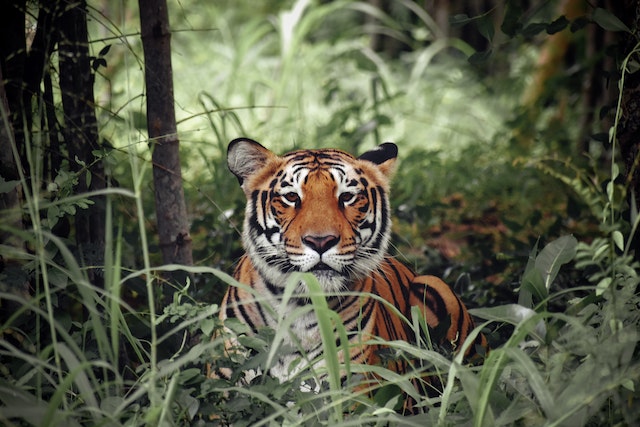
How does animal camouflage work? It works by upsetting the edges, mimicking shadows and background, copying shapes, scattering light and countershading, and hiding movement.
Camouflage is obviously an evolved trait. All animals have gradually become the color and the shape that they are because it offered an advantage in that they weren’t eaten and got to pass on their genes. Over time, the better the camouflage, the more likely they were to survive and camouflage methods have slowly improved.
There are several ways that animals hide themselves and we have to remember that each animal with camouflage is disguising itself from a specific set of predators or prey. We might think that we can see some animals pretty easily, and we might find ourselves wondering how they can hide. For example, tigers hide in the forest or jungle. Tigers are orange and black, jungles are green with black shadows. Tigers stand out very clearly to us, but we have trichromatic color vision. That means we have cones in our eyes that detect red, green, and blue color wavelengths. We can combine these to make other colors. Some animals, such as birds, can see even more colors than we can, but some animals, such as deer, can see far fewer. Deer have dichromatic color vision, which means they can only detect blue and green wavelengths. They don’t have the ability to detect reds and yellows, so they would see the orange and black tiger as green and black. Tigers prey on dichromatic animals, and so they are well hidden. That is an advantage for the tiger, because there is no way to grow green fur. Different pigments in hair produce different colors, but there is no pigment that can make green hair.
The first job of camouflage is to break up the edge of an animal’s shape. This is called disruptive coloration. Most creatures with eyes see objects by using edge detection. When we are looking to find a shape, we start off by trying to find the edge of the object. Once we have done that, we can work out what the shape is. By breaking up their edges and stopping them being distinct from the background, animals can successfully hide. There are different ways of doing this and it depends on what the animal is covered with. Scales can grow in different shapes. They can become jagged, to confuse the edge of the animal’s shape. Fur doesn’t grow as quickly and it isn’t possible to have it grow in different shapes, so animals with fur that want to camouflage themselves use shading to make their edges blurry or to make their edges appear jagged. Tigers, again, are a good example. Their black stripes look like shadows and continue up and over their backs, preventing any animal from being able to tell where their edge is.
A common method of camouflage is to use shading to mimic shadows and the background. Some owls are a good example of this. Owls that nest on tree branches will quite often have a coloration that matches that of the tree behind them. A lot of animals use this method. There is the famous story of the white moth in London during the early 20th century when the smog was at its worst. All the buildings became black with soot and the white moths stood out. Very quickly, the moths became black because all of the white ones were eaten. Then, after a few years, they cleaned up the town and the buildings were white again. The black moths now stood out and very quickly all the moths had become white again. Many frogs use shading to mimic the leaves that they rest on.
Copying shapes is a method that not all animals can achieve. Stick insects are probably the most famous insects when it comes to looking like something. They can famously shape themselves like the sticks and leaves that they live among. Unless you know what you are looking for, it can be very difficult to see them.
Some animals use light to their advantage. The fiery-necked nightjar nests on the ground and hides amongst the leaves. They are able to angle their feathers in a way that light scatters off them in different directions, making them completely blend into the leaves they are nesting in. When they stay motionless, they are pretty much impossible to see. Other animals use countershading to camouflage themselves. Penguins are a good example of this. They are black on top because animals looking down from above will only be able to see the dark water and the penguins want to blend in with that. However, they are white on their fronts because any animal looking up from the deep sea will only see the lighter color of the sky and the penguins want to blend in with that.
The best method of camouflage is to remain motionless. Most animals, ourselves included, are able to see best when we detect motion. If something can remain motionless, it is very hard to see. This is why cats move so slowly when they are hunting.
There is, of course, the opposite side of the spectrum. Some animals hide in plain sight. Animals that are poisonous or venomous are usually bright colors so that an animal doesn’t try to eat them by mistake. Their goal is to stand out as much as possible to show that they are deadly. There are actually a few animals that are not venomous but are highly colored to trick other animals into believing that they are dangerous. A very brave bluff.
There are also animals that are able to change their colors to match different backgrounds,, but we looked at that before. And this is what I learned today.
Sources
https://www.newscientist.com/lastword/mg25033370-800-why-are-there-no-green-mammals/
https://www.livescience.com/why-are-tigers-orange
https://animals.howstuffworks.com/animal-facts/animal-camouflage.htm
https://www.ncbi.nlm.nih.gov/pmc/articles/PMC2674078/
https://www.nhm.ac.uk/discover/can-you-spot-hidden-animals-cunning-camouflage.html
https://www.ncbi.nlm.nih.gov/pmc/articles/PMC2674079/
https://education.nationalgeographic.org/resource/camouflage/
https://www.bbc.com/future/article/20191031-the-truth-behind-why-zebras-have-stripes
